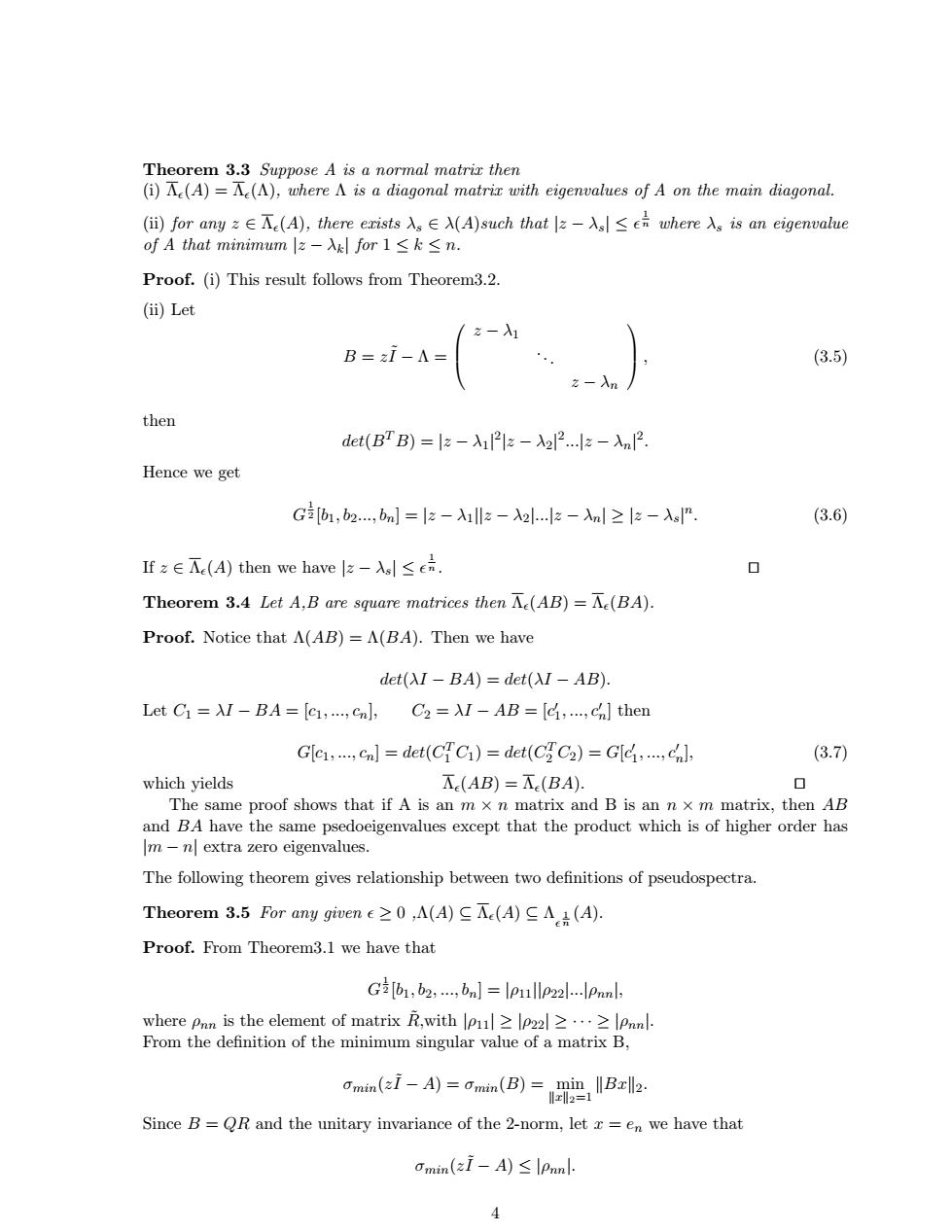正在加载图片...

Theorem 3.3 Suppose A is a normal matrix then (i)A(A)=A(A),where A is a diagonal matrix with eigenvalues of A on the main diagonal. (i)for any z∈工e(A),there erists入s∈A(A)such that z-入sl≤e六whee入s is an eigenvalue of A that minimum z-入k for1≤k≤n. Proof.(i)This result follows from Theorem3.2. (i))Let B-:1-A (3.5) then det(BTB)=Iz-A1l2lz-212...J-An2. Hence we get G[b1,b2,bn=z-1lz-2lz-入n≥z-入sm (3.6) Ifz∈c(A)then we have-Asl≤e. ◇ Theorem 3.4 Let A,B are square matrices then Ae(AB)=Ae(BA). Proof.Notice that A(AB)=A(BA).Then we have det(AI-BA)det(XI-AB). Let C1=AI-BA=[c1...,cn],C2=AI-AB=[d,...,ch]then Glc1,...,cn]det(CfC1)=det(CC2)=Gld,. (3.7) which yields K(AB)=K(BA). 0 The same proof shows that if A is an m x n matrix and B is an n x m matrix,then AB and BA have the same psedoeigenvalues except that the product which is of higher order has m-n extra zero eigenvalues. The following theorem gives relationship between two definitions of pseudospectra. Theorem3.5 For any given c≥0,A(A)Sc(A)∈Ah(A). Proof.From Theorem3.1 we have that G b2on]=Ipiillp221...IPnnl, where Pnn is the element of matrix R,with IPu≥lp22l≥·≥IPnnl From the definition of the minimum singular value of a matrix B, omin(A)=doin(B) Since B =QR and the unitary invariance of the 2-norm,let x =en we have that omin(zi-A)≤IPnnl 4Theorem 3.3 Suppose A is a normal matrix then (i) Λ²(A) = Λ²(Λ), where Λ is a diagonal matrix with eigenvalues of A on the main diagonal. (ii) for any z ∈ Λ²(A), there exists λs ∈ λ(A)such that |z − λs| ≤ ² 1 n where λs is an eigenvalue of A that minimum |z − λk| for 1 ≤ k ≤ n. Proof. (i) This result follows from Theorem3.2. (ii) Let B = z ˜I − Λ = z − λ1 . . . z − λn , (3.5) then det(B T B) = |z − λ1| 2 |z − λ2| 2 ...|z − λn| 2 . Hence we get G 1 2 [b1, b2..., bn] = |z − λ1||z − λ2|...|z − λn| ≥ |z − λs| n . (3.6) If z ∈ Λ²(A) then we have |z − λs| ≤ ² 1 n . ut Theorem 3.4 Let A,B are square matrices then Λ²(AB) = Λ²(BA). Proof. Notice that Λ(AB) = Λ(BA). Then we have det(λI − BA) = det(λI − AB). Let C1 = λI − BA = [c1, ..., cn], C2 = λI − AB = [c 0 1 , ..., c0 n ] then G[c1, ..., cn] = det(C T 1 C1) = det(C T 2 C2) = G[c 0 1 , ..., c0 n ], (3.7) which yields Λ²(AB) = Λ²(BA). ut The same proof shows that if A is an m × n matrix and B is an n × m matrix, then AB and BA have the same psedoeigenvalues except that the product which is of higher order has |m − n| extra zero eigenvalues. The following theorem gives relationship between two definitions of pseudospectra. Theorem 3.5 For any given ² ≥ 0 ,Λ(A) ⊆ Λ²(A) ⊆ Λ ² 1 n (A). Proof. From Theorem3.1 we have that G 1 2 [b1, b2, ..., bn] = |ρ11||ρ22|...|ρnn|, where ρnn is the element of matrix R˜,with |ρ11| ≥ |ρ22| ≥ · · · ≥ |ρnn|. From the definition of the minimum singular value of a matrix B, σmin(z ˜I − A) = σmin(B) = min kxk2=1 kBxk2. Since B = QR and the unitary invariance of the 2-norm, let x = en we have that σmin(z ˜I − A) ≤ |ρnn|. 4